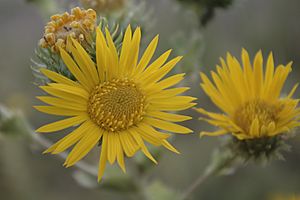Grindelia ciliata facts for kids
Quick facts for kids Grindelia ciliata |
|
|---|---|
 |
|
| Scientific classification | |
| Genus: |
Grindelia
|
| Species: |
ciliata
|
| Synonyms | |
|
|
Grindelia ciliata is a type of flowering plant. It is part of the daisy family. People often call it Spanish gold, goldenweed, or waxed goldenweed. This plant has a few other scientific names, like Grindelia papposa.
Contents
Where Does Spanish Gold Grow?
Grindelia ciliata is native to parts of the central United States. You can mostly find it in the Great Plains region. This includes states like Iowa, Nebraska, Texas, and New Mexico.
Sometimes, you might also see it in Arizona. It has also spread to other areas. These include California, Maryland, Michigan, and the Mississippi Valley.
What Kind of Places Does It Like?
This plant loves open spaces. It grows well in prairies and grasslands. You can also spot it in places where the ground has been disturbed. This includes roadsides and along railroad tracks.
What Does Spanish Gold Look Like?
Grindelia ciliata can be an annual or biennial plant. This means it lives for one or two years. It can grow quite tall, sometimes up to 150 centimeters (about 5 feet). Its upper stem branches out. The plant itself is smooth and does not have hairs.
Leaves and Flowers
The leaves of the Spanish gold plant grow one after another along the stem. They can be up to 8 centimeters (about 3.2 inches) long. Their edges have small, spiny teeth. The leaves are longer than they are wide.
At the top of the stem, you will find several flower heads. These flower heads look like small hemispheres. They can be up to 2.5 centimeters (one inch) wide. Many small, green phyllaries (leaf-like parts) line the base of the flower head. These phyllaries have tips that curve.
Each flower head can have up to 30 bright yellow ray florets. These are the "petals" you see around the edge. They are narrow and pointed, about 1 to 2 centimeters (0.4-0.8 inches) long. In the center, there are many yellow disc florets.
Seeds and Reproduction
After the flowers bloom, the plant produces a fruit. This fruit is a brown achene. An achene is a small, dry fruit that contains one seed. It is about a centimeter (0.4 inches) long. The achene also has a long pappus made of bristles. The pappus helps the seeds spread, often by wind.
See also
 In Spanish: Grindelia ciliata para niños
In Spanish: Grindelia ciliata para niños

